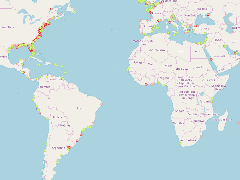- Title
- Global oceanic eutrophication and hypoxia hotspots and reported fish decline
- Abstract
Human activities such as agriculture, domestic and industrial wastewater as well as natural processes may cause excessive nutrient loads, known as eutrophication. Increased nutrient loads can lead to many adverse effects including harmful algal blooms, and in extreme cases hypoxia. Hypoxia, or oxygen depletion, is an environmental phenomenon where the concentration of dissolved oxygen in the water column decreases to a level that can no longer support living aquatic organisms. Mitigation of the negative effects of eutrophication requires reduction of nutrient inputs and an ecosystem-based management strategy.
The map shows the location of water bodies impacted by eutrophication and reported hypoxia and impacts (fish reduction) between 1985 and 2000. The data is sourced from the World Resource Institute (https://www.wri.org/resource/interactive-map-eutrophication-hypoxia). The pat...
- Publication Date
- May 2, 2019, 4:08 a.m.
- Published
- Yes
- Featured
- No
- Name
- Global_Nutrient_Cycle
- Position
- Organization
- Location
- Voice
- Fax
- Spatial Resolution
- ---
- Projetion System
- EPSG:4326
- Extension x0
- -87.8913268119
- Extension x1
- 87.8913268119
- Extension y0
- -61.5239287683
- Extension y1
- 61.5239287683
- Language
- English
- Supplemental Information
No information provided
- Name
- Global_Nutrient_Cycle
- Position
- Organization
- Location
- Voice
- Fax
- Link Online
- /maps/4088
- Metadata Page
- /maps/4088/metadata_detail
- Thumbnail
- Global oceanic eutrophication and hypoxia hotspots and reported fish decline.png
- Thumbnail
- Global oceanic eutrophication and hypoxia hotspots and reported fish decline.png
- Remote Thumbnail
- Global oceanic eutrophication and hypoxia hotspots and reported fish decline.png
- Remote Thumbnail
- Global oceanic eutrophication and hypoxia hotspots and reported fish decline.png
- Name
- Global_Nutrient_Cycle
- Position
- Organization
- Location
- Voice
- Fax
